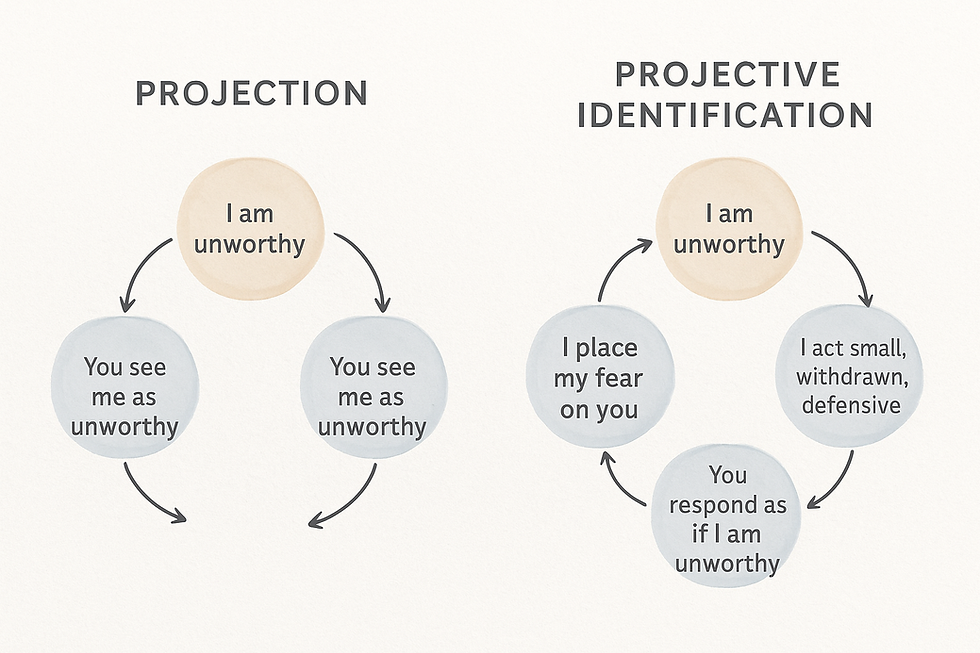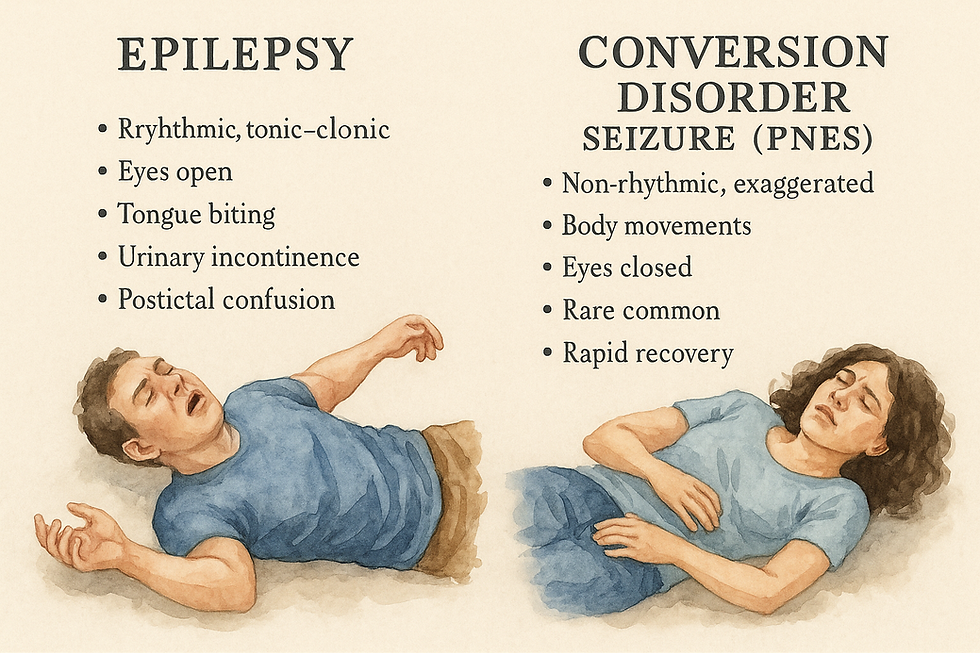Projective Identification: Self- fulfilling prophecy.
- Sep 4
- 6 min read
Updated: Sep 5
Who Coined It & Where It Appears Most
Coined by: Melanie Klein (1946, Notes on Some Schizoid Mechanisms). She used it to describe how infants split off unbearable parts of themselves and “put them” into the caregiver.
Most common in: Borderline Personality Disorder and psychotic states, but elements appear in everyday relationships too (especially in intimate or high-stress dynamics).
Projection vs Projective Identification (Plain Talk)
Projection: In my head only. I see my unwanted feelings in you. Example: I’m angry but I say, “Why are you so mad at me?” I never own my anger, I just assume it belongs to you.
Projective Identification: In my head + in our relationship. I’m angry, I can’t handle it, so unconsciously I push it into you. I act in ways that provoke you until you actually become angry. Now I can say, “See? You’re the angry one,” and it feels real.
Who is projecting on whom? The person who cannot tolerate the feeling projects it onto someone else. The recipient may then feel compelled to act it out.
Sometimes what we fear the most is exactly what we create. This is the heart of projective identification. I used to think of it as just overthinking, until I realized—it’s like a self-fulfilling prophecy. When I believe “I am unworthy,” I start to act small, defensive, or apologetic. The other person, often without realizing, responds by dismissing me. And then my fear feels true. The loop is complete.
The Roots of Projective Identification
The term comes from Melanie Klein (1946), one of the founders of object relations theory. She noticed how infants “place” their unbearable feelings into their caregivers—crying, pushing, even agitating—so the caregiver feels what the infant cannot bear. In adults, this can become a defense mechanism. Commonly seen in Borderline Personality Disorder, it’s also present in everyday life: lovers, friends, parents, and children can all unconsciously pull each other into this loop.
Projection vs Projective Identification
In projection, the feeling stays in your mind but gets pasted onto another person.
In projective identification, you don’t just paste it—you pull the other person into acting it out. That’s why it feels so convincing.

If it’s Simple Projection
Person thinks: “I am unworthy.”
Too painful → they disown it.
They tell themselves: “You see me as unworthy” or “You are the unworthy one.”
The belief stays in their mind but gets pasted onto the other person.
Effect on you: You feel accused, misunderstood, blamed.
Example: “You don’t respect me!” (when the person is actually struggling to respect themselves).
If it’s Projective Identification
Person thinks: “I am unworthy.”
They act in ways (apologetic, defensive, self-sabotaging) that subtly pressure you into treating them as unworthy.
You may find yourself dismissing them, getting impatient, or minimizing them — even though you didn’t intend to.
Now the loop is complete: “See? I am unworthy.”
Effect on you: You feel pulled into a role, almost forced to enact their script.
How It Works Like a Self-Fulfilling Prophecy
Belief: “I am unworthy.”
Projection: That unworthiness is unconsciously pushed onto the other person (“You see me as unworthy”).
Behavioral Induction: You might act withdrawn, apologetic, or defensive — subtly inviting the other person to treat you as lesser, dismiss you, or confirm the belief.
Loop Completion: The other person responds in a way that validates your fear. Now the inner narrative feels “proven true.”
This cycle is why projective identification is so powerful — it doesn’t just distort perception; it shapes the relational field so that what you fear becomes enacted between you and the other.
Diagram

Loop (Belief → Projection → Behavior → Confirmation) was actually illustrating projective identification, not simple projection.
The “belief” (I am unworthy) gets projected outward.
The “behavior” (acting small, defensive) induces the other person’s confirming response.
The “confirmation” seals the prophecy.
If it had been only projection, the diagram would stop at:
Belief (I am unworthy) → “You see me as unworthy.”(no behavior or induction needed).
So:
Projection = mental shortcut. (“It’s not me, it’s you.”)
Projective Identification = relational shortcut. (“I’ll make you act it out so I can prove it’s true.”)
Key Difference from Simple Projection
In projection, the distortion stays in your mind (“You’re the unworthy one”). In projective identification, the distortion spills into the relationship, creating conditions that make the other unconsciously live out or confirm what you feared.
Example in Relationships
A partner who fears abandonment may become clingy or accusatory.
Their behavior pressures the other into pulling away.
The pull-away confirms the inner fear: “See, I always get abandoned.”
Projective identification creates the reality it fears, and that’s why it is so relationally toxic but also so subtle, like self fulfilling prophesy. A Case Study in Dialogue

Client enters with belief: “I am unworthy.”
Client: “I know you probably think I’m wasting your time. You must have better clients than me.”
Therapist (thinking): I don’t think that, but I suddenly feel a wave of irritation, like I need to prove my value.
Therapist (gently): “It sounds like a part of you feels unworthy here with me. Can we notice that feeling together?”
Client: (sighs) “See? You’re being nice now, but one day you’ll get tired of me.”
Therapist: “I wonder if this fear is asking me to play the role of someone who rejects you. Instead of going into that script, can we pause and look at the fear itself?”
Here, the client projects their belief of unworthiness. Their tone and words pressure the therapist into feeling dismissive. If the therapist reacts defensively, the client’s prophecy is fulfilled. But by naming it, the loop breaks.
Students often get confused - between projection and projective identification
Projection (Narcissistic Style)
What it is: A defense mechanism where the narcissist denies their own unwanted feelings and attributes them to someone else.
Example: A narcissistic parent who feels envious says, “You’re so jealous of others!”
Key Point: The feeling never leaves their head — it’s just reassigned to you. They don’t necessarily push you to act it out; they just accuse or assume.
Projective Identification
What it is: A deeper, more relational defense. Here, the person unconsciously pressures you to embody the feeling they cannot tolerate.
Example: A partner who feels deep anger but can’t own it acts cold, provocative, or dismissive until you explode. Then they say, “See? You’re always the angry one.”
Key Point: It’s not just labeling you — it manipulates the interaction so you become the container for their disowned feeling.
Where Narcissistic Projection Fits
Projection is the narcissist’s go-to tool: blame-shifting, accusing, gaslighting.
Projective Identification may also appear in narcissistic dynamics, but it’s more sophisticated and relational.
Think of it like this:
Projection = throwing the hot potato at you.
Projective Identification = making you hold the potato and burn your hands, so they feel cooler.
In Therapy Context
Projection: Client says, “You’re judging me,” when really they are judging themselves.
Projective Identification: Client’s subtle behaviors (silence, sarcasm, testing) pull the therapist into actually feeling judgmental, irritated, or dismissive.
So — they’re related but not identical. Projection is simpler: “It’s not me, it’s you.” Projective Identification is relational: “It’s too much for me, so I’ll put it in you and make you carry it.”
Narcissistic Projection
Narcissists use projection most often.
They take the feelings they can’t tolerate (shame, envy, fear, inadequacy) and throw them onto others.
It’s usually blunt, blaming, or accusatory.
Example: “You’re so selfish!” (when in truth they are being selfish).
Target: Anyone close — partner, child, colleague.
Borderline Personality & Projective Identification
In BPD, the more common defense is projective identification (though projection also occurs).
Instead of just accusing, the person unconsciously pulls the other person into the role that fits their inner fear.
Example: “I’m scared you’ll leave me.” → They become clingy, accusatory, testy. The partner feels suffocated and pulls away → confirming the abandonment fear.
Target: Usually attachment figures — the people they’re most afraid of losing.
The Difference in Feel:
With a narcissist’s projection, you feel accused.
With BPD’s projective identification, you feel pushed into a role you didn’t choose.
So to answer your direct question:
Narcissist will project onto others (often harshly, to protect their grandiose self).
BPD individual will project into the other person, especially attachment figures, so that person begins to live out the feared role (rejector, abandoner, critic).
Tips for Therapists
Name the energy without blame: “It feels like something is pulling us into a pattern.”
Anchor yourself: Don’t react defensively; regulate your own emotions.
Externalize the loop: Make the dynamic the “third thing” in the room instead of you vs. client.
Invite reflection: Help the client notice the belief behind the behavior.
Closing Note
Projective identification is not a monster—it’s just the mind’s way of protecting itself from unbearable feelings. But left unchecked, it traps both people in a painful loop. In therapy, we learn to pause, notice, and name it—so that what feels like destiny can finally be seen as a defense. Once seen, it can be softened. Once softened, it can be healed.




Comments